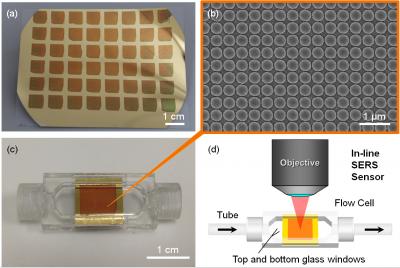
The system is extremely sensitive: it can detect drugs in amounts 100 times lower than the clinically delivered drug concentrations commonly used
Today, computerized smart systems can deliver drugs intravenously in exact volumes to hospital patients. However, these systems cannot recognize which medications are in the tubing nor can they determine the concentration of the drug in the tubing. This lack of precise information can lead to medication errors with serious consequences.
Now, a new optical device developed by a team of electrical and computer engineering students at the University of Illinois at Urbana-Champaign (UIUC) can identify the contents of the fluid in an intravenous (IV) line in real-time, offering a promising way to improve the safety of IV drug delivery. The team, led by Prof. Brian T. Cunningham, interim director of the Micro and Nanotechnology Laboratory at UIUC, will present its work at The Optical Society’s (OSA) Annual Meeting, Frontiers in Optics (FiO) 2013, being held Oct. 6-10 in Orlando, Fla.
The vulnerability of IV drug-delivery systems due to human error is a chief concern in hospital safety, Cunningham said. Errors can include incorrect dosage, unintentional substitution of one drug for another, and co-delivery of incompatible drugs.
“Up to 61 percent of all life-threatening errors during hospitalization are associated with IV drug therapy,” Cunningham said, citing a recent report. “So for all the really good things hospitals can do, the data shows that mistakes can occasionally happen.”
To approach this problem, Cunningham and colleagues turned to the very small – to structures and processes at the nanoscale (one-billionth of a meter), where novel physical and chemical properties arise. The researchers use a technology called Surface-Enhanced Raman Scattering (SERS), a powerful analytical tool prized for its extreme sensitivity in obtaining molecular signals that can be used to identify chemicals. To determine the identity of a particular IV medication, researchers shine laser light onto a nanostructured gold surface that contains millions of tiny “nano-domes” that are separated from each other by as little as 10 nanometers. The nano-domes are incorporated into the inner surface of IV tubing, where they are exposed to drugs that are dispersed in liquid. They capture the light scattered from drug molecules that are in contact with the nano-domes and use SERS to determine the drug’s molecular signature. Finally, they match the signature to known signatures for the drug in order to confirm the presence of a specific medication in the IV line.
While other groups have demonstrated excellent nanostructured surfaces for SERS, those developed by the Cunningham group are unique because they are inexpensively produced on flexible plastic surfaces by a replica molding process with nanometer scale accuracy.
Early data show that the Cunningham group’s system can identify medications including morphine, methadone, phenobarbital, the sedative promethazine, and mitoxantrone, which is used to treat multiple sclerosis. The system is extremely sensitive: it can detect drugs in amounts 100 times lower than the clinically delivered drug concentrations commonly used. So far, the researchers have also shown their system can sense a two-drug combination, which has its own unique signature.
The next step is further evaluation for combinations of up to ten drugs being delivered at the same time.
The Latest on: Detector for IV delivered drugs
[google_news title=”” keyword=”Detector for IV delivered drugs” num_posts=”10″ blurb_length=”0″ show_thumb=”left”]
via Google News
The Latest on: Detector for IV delivered drugs
- Prevention of Intravenous Drug Incompatibilities in an Intensive Care Uniton March 30, 2024 at 5:01 pm
Purpose: The frequency of drug administration errors and incompatibilities between intravenous drugs before and after an intervention in an intensive care unit (ICU) is discussed. Methods ...
- News tagged with drug delivery systemon January 23, 2024 at 4:00 pm
Treating complex diseases such as skin cancer often requires simultaneous administration of multiple anticancer drugs. The delivery of such life-saving therapeutic drugs has evolved with the rise ...
- Nexium Ivon October 15, 2021 at 6:46 am
Esomeprazole (as sodium) 20mg, 40mg; per vial; pwd for IV inj after reconstitution or for ... May reduce absorption of gastric pH-dependent drugs (eg, iron salts, erlotinib, dasatinib, nilotinib ...
- Self-nanoemulsifying Drug Delivery Systems: Formulation Insights, Applications and Advanceson October 6, 2021 at 6:30 am
Self-nanoemulsifying drug delivery systems (SNEDDS) are anhydrous homogenous liquid mixtures consisting of oil, surfactant, drug and coemulsifier or solubilizer, which spontaneously form oil-in ...
- Drugs & Medications A-Zon January 11, 2021 at 6:55 pm
The display and use of drug information on this site is subject to express terms of use. By continuing to view the drug information, you agree to abide by such terms ...
- Drug Deliveryon October 11, 2018 at 9:47 am
Now a colour-changing contact lens to serve as a potent drug delivery agent for eyes, found the scientists. The scientists have come up with another breakthrough in drug delivery to prevent the ...
- Immune Globulin Intravenous Interaction with other Drugson August 29, 2018 at 10:30 pm
Immune Globulin Intravenous is a blood product administered intravenously, prescribed for primary immunodeficiency. The therapeutic efficacy of Bacillus calmette-guerin substrain connaught live ...
- Ketorolac Iv/imon December 30, 2011 at 10:10 am
Ketorolac tromethamine 15mg/mL, 30mg/mL; for IM or IV inj; contains alcohol ... Epidural or intrathecal inj. Labor & delivery. Increased risk of serious cardiovascular events, MI, and stroke.
- Drug detector to be used in clubson March 14, 2003 at 4:00 am
POLICE in Southampton will be the first in Hampshire to use a high-tech computerised drugs testing machine at some of the city's most popular clubs and pubs over the weekend. Today and tomorrow ...
via Bing News









